(self) Lilac: aa CC D* E* pp Uw*
Lilac is one of the commonly-found ‘grey’ (or ‘silver’ as we like to call it) coat colors of the Mongolian gerbil. This color is created when a Black gerbil inherits two Pink Eye genes – and is where the whole coat is dark silver, including the tummy.
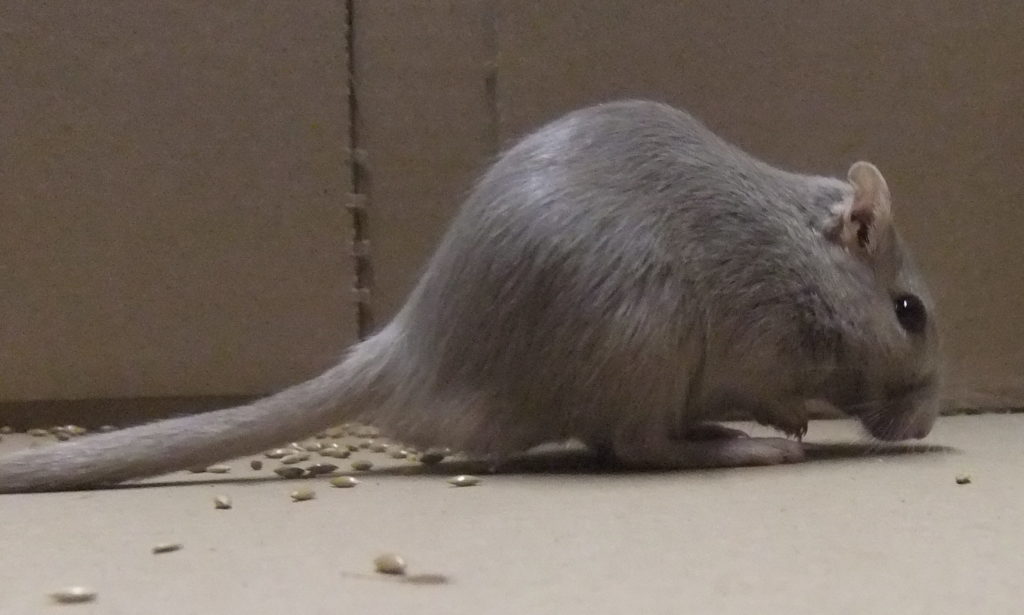
This color is one of three shades of silver-colored gerbils found – using the two most common gerbil colour genes – the Agouti gene and Pink Eye gene (see below). However, due to most gerbil lines carrying the chinchilla medium colorpoint gene, this isn’t the most common of the three silver shades – Sapphire is.
Lilac is the darkest of the three shades (as it has no colorpoint dilution) followed by Sapphire (the middle color) then the much rarer Dove is the palest. The reason Dove is least common and not often found is because the gene to create it is usually found in specific colorpoint lines (creating Siamese) – where pink eyes is a big no-no.
Add the genes for colorpoint to any of these three silver colors and they all bleach out into Pink-Eyed Whites (below image) – no silver at all. You can’t have visibly colorpoint Lilacs.
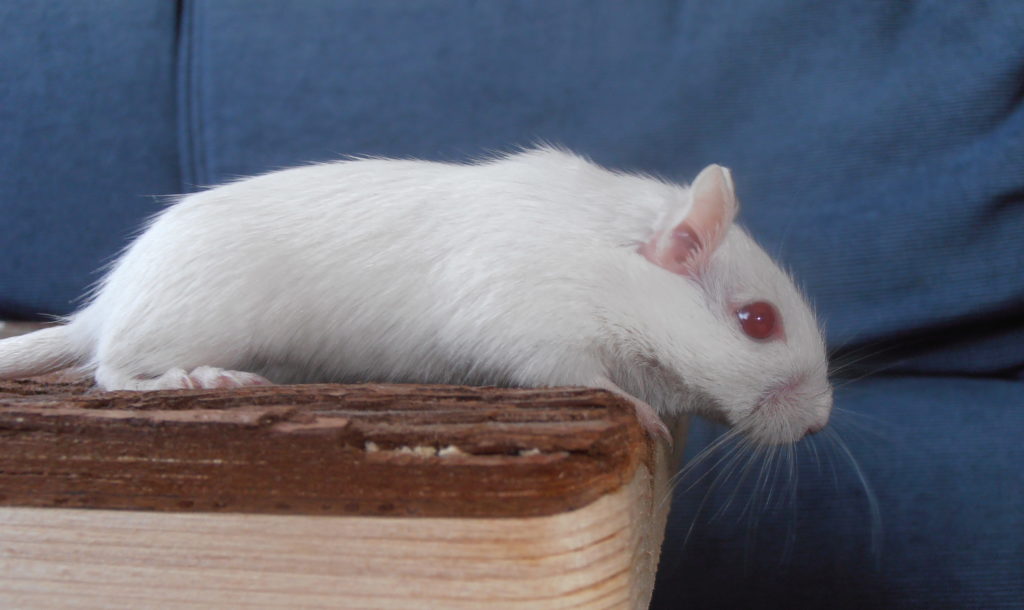
Additionally, all colorpoint genes are affected by temperature and so these 3 colors can be hard to differentiate between if you don’t know your stuff – they sort of fade into each other. A light Lilac can look like a dark Sapphire and a dark Dove can look like a light Sapphire. Spotting makes it worse and can lighten the coat further. Nightmare.
This is why there usually isn’t a show class for Sapphire – it is too hard to describe – so you either show very dark silver gerbils in the Lilac class or very light silver gerbils in the Dove class – it doesn’t actually matter genetically what they are inside (like any beauty pageant).
These colors are the exact genetic pairs of the ‘Argente’ group which follow the same colour and genetic patterns.
Lilac is the [aa] equivalent of the very ginger Argente Golden, Sapphire is the [aa] equivalent of the slightly paler Argente Fawn, and Dove the final ‘Silver’ is the much rarer [aa] equivalent of the wonderfully pale Argente Cream.
Pink Eyes in the population:
The gene that creates the silver colour in these guys – the Pink-Eyed gene – works by diluting all the pigment forming cells in a growing embryo – this results in the black being lost from the eyes (leaving them pink) and in this case it has the effect of removing all the black from the hairs too leaving the gerbils silver – basically a Lilac gerbil is a black gerbil with all its black pigment missing.
This gene has the same effect on the Golden Agouti coloring and creates the three Argente shades. It strips out the black from the eyes too but it also strips out all the black from the tips of the coat leaving only the gingery color underneath (it doesn’t affect the silver undercoat which you can still see on an Argente by parting the fur – and Argente actually means ‘silver’).
The actions of this gene is also associated with poor eyesight as these gerbils now have no protection from the sun and you can see straight into the blood vessels and tissues – hence the pink colour.
The black pigment in the iris generally blocks out the harmful effects of the sun – but it isn’t there in gerbils with pink, ruby and red eyes. As a result, over time the effects of sunlight will damage some of the delicate tissues in the eyes which are now unprotected.
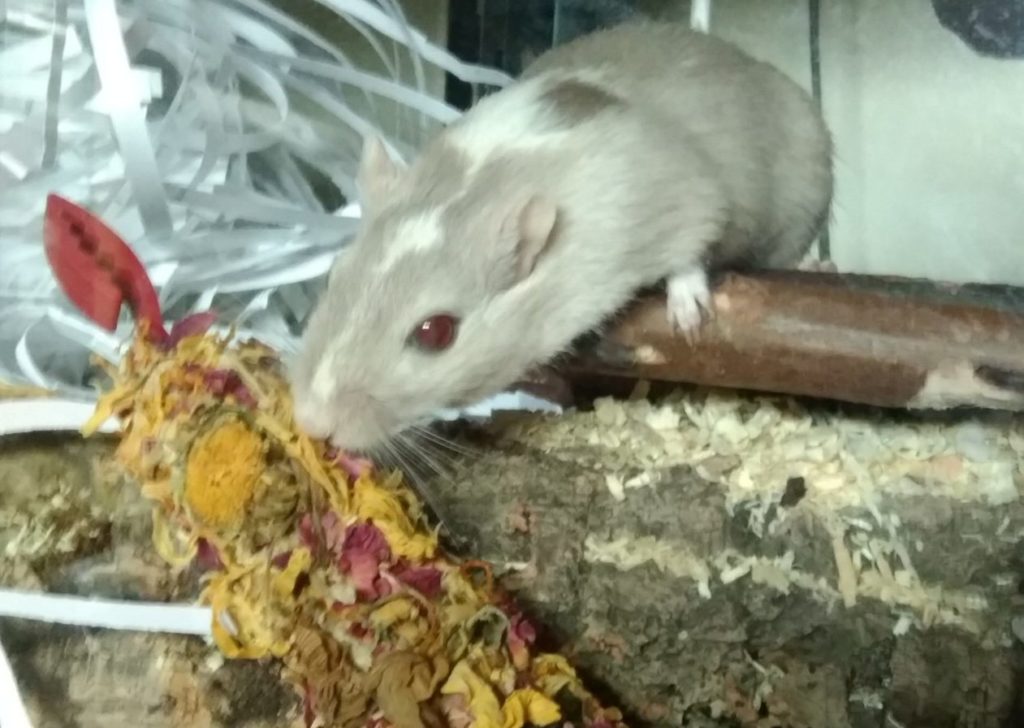
I’m not sure if it IS Lilac yet?
Well, as described above, there is certainly Sapphire that is can be (see image right) – and this is about the size of it.
You often can’t be sure what they are genetically without breeding them – but the genes for the Lilac are often prized as helping your line to rid itself of the diluting effects of the colorpoint genes. So sometimes it is worth test breeding them to find out.
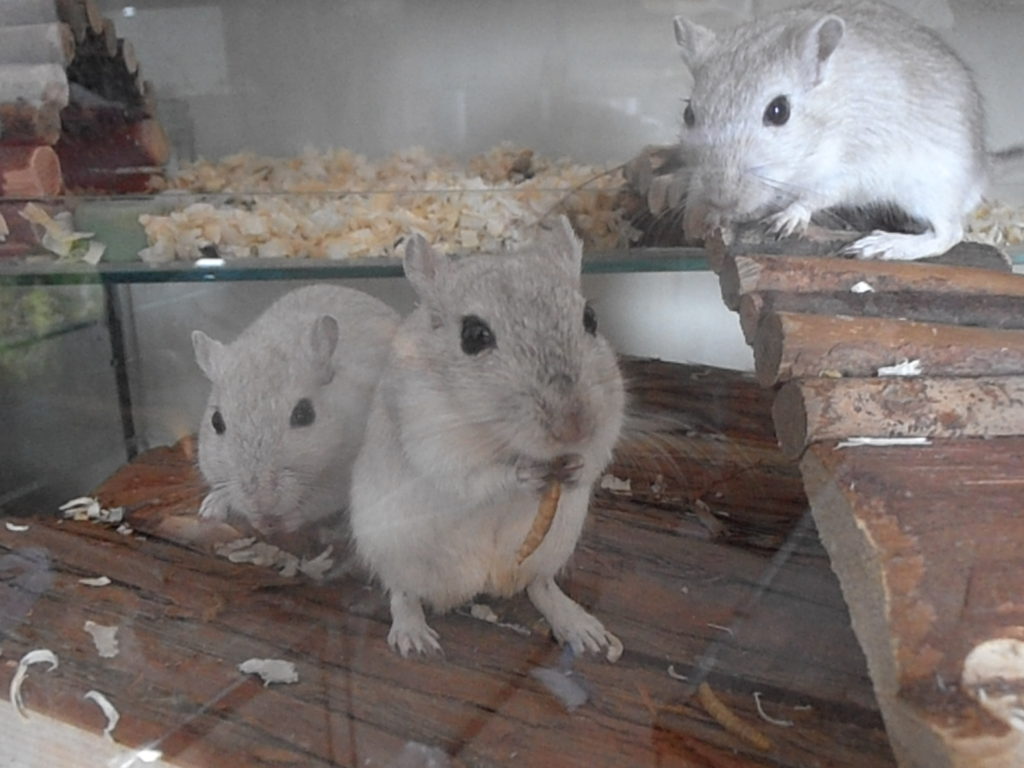
However, Lilac/Sapphire is so different to other grey gerbils – that even though there are many other silvery gerbils out there – they are almost all able to be told apart from a Lilac instantly if the gerbil you are trying to identify isn’t spotted.
Grey Agoutis, Light Grey Agoutis, CP Grey Agoutis (see image right for these three), LCP Grey Agoutis, CP Golden Agoutis, LCP Golden Agoutis, Polar Foxes, Light Polar Foxes, CP Polar Foxes, LCP Polar Foxes can all be light grey or have a grey tinge to them – but ALL of them have a white tummy – usually a very obvious white tummy.
So no matter how grey they look – they can’t possibly be a Lilac.
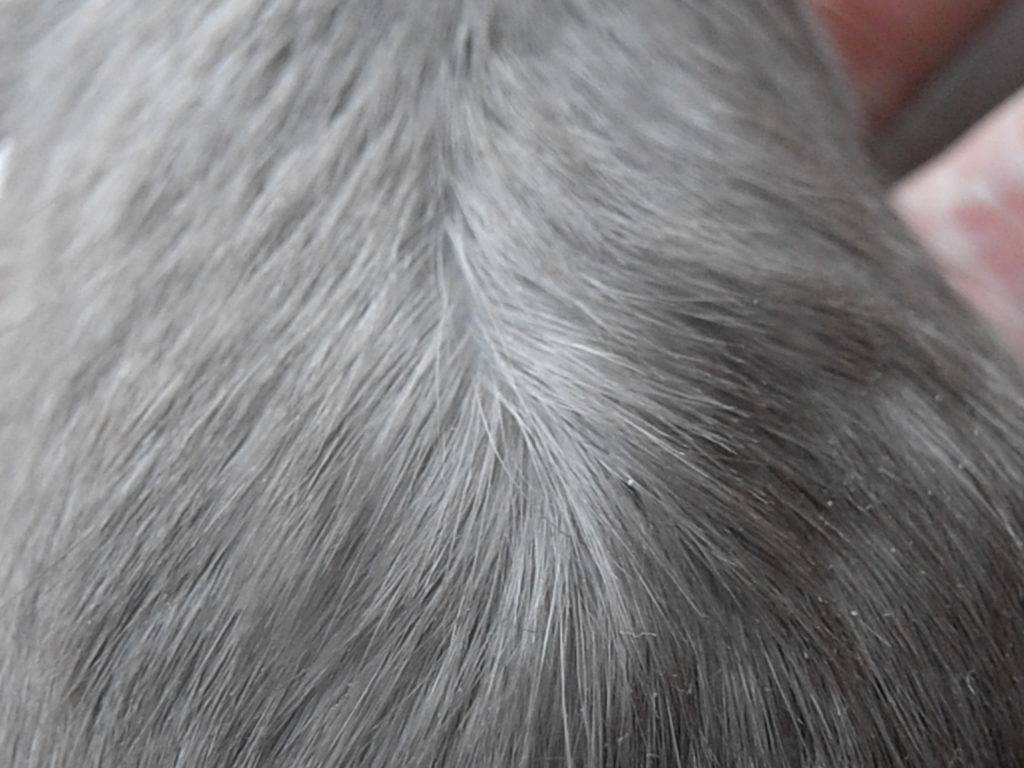
If in doubt – rub the hair on the body backwards. A Lilac’s will be silver from top to bottom (see image right) – all the other gerbils listed above will have different color hair underneath the ticked surface.
There are also Light, CP and LCP Silver Nutmegs to contend with – who are also greyish – and don’t have a white tummy – but you can clearly see the smooth ‘full’ color of the Lilac (and other silvers) – it is unmistakable to the untrained eye even.
You have Lilac gerbils you want to Breed?
Due to the prevalence of all the dominant genes needed to create a Lilac gerbil, this colour is one of the most easily created gerbil colours in litters. However, it can be hard to get a Lilac pup from random genes due to the prevalence of the chinchilla medium gene (which everyone seems to want to breed into their lines).
Genetics-wise, the genes for a Lilac gerbil are quite ‘strong’ (strong in this instance means prevalent and dominant), so if you mate a Lilac gerbil to any other non-colorpoint gerbil on the self side, you will probably get Lilac pups in the mix.
You want Lilac Pups?
There are loads of different ways to get Lilac pups in you litters depending on the colors you already have and the genes you already know about.
If you want 100% Lilac pups you would need two Lilac parents with no other recessives.
However, to get a large percentage of Lilacs in your litters if you don’t have two Lilac parents, do one or all of the following things:
Only breed gerbils on the self side
Basically do not breed any agouti-based colours or any double-sided colours (colours that could actually be either A* or aa but you can’t tell by just looking) – avoid for example PEWs, Himalayans or BEWs (unless you definitely know their parentage).
By eliminating the dominant Agouti gene [A] you are doubling your chances of getting Lilacs right there. Easy.
Only breed gerbils with red/pink eyes (which are not white)
Basically breeding only pink-eyed gerbils means you will be eliminating all the dark-eyed colors (Nutmeg, Polar Fox etc) – which effectively doubles the chances of you getting Lilac pups instantly – breeding a Lilac to any Argente colour would be perfect.
However, be careful not to use two gerbils with the same sets of additional recessives – like eepp or ddpp – as otherwise you will only get pups with those (i.e. don’t breed two Red Foxes, or a Red Fox to a Yellow Fox – as all the pups will be pink-eyed ee gerbils = no Lilacs in that pie).
Avoid all colorpoint colours completely (including PEWs)
By avoiding any gerbils with known or suspected colorpoint genes – you are dramatically increasing your chances of making Lilac pups as Lilac gerbils don’t have or carry a colorpoint gene themselves (if they did, they would be Sapphire or Dove).
PEWs are colorpoints – as are Himalayans – which will both ruin your chances of getting Lilacs right there before you have even started. It’s a no go.
However, there are also a few white or light cream gerbil colors with pink/red/ruby eyes that aren’t colorpoint that you could use (Apricot and Ruby-Eyed White (REW)) – but unless you can be 100% sure of this – don’t use them.
Be aware though for your long-term breeding plan: including colorpoint, dark-eyed or agouti-based gerbils won’t necessarily prevent you getting Lilac pups – they will just lower the numbers of Lilac pups you will get on average because you will be getting other colours.
We still get the odd Lilac pup in a Rainbow Litter, but they are few and far between.
Don’t have Lilac gerbils – but want them?
If you don’t have any Lilac gerbils of your own but still want them – you could try one of the 3 following plans to get them…
1) Breed any red-eyed self-based gerbil with a Black gerbil ( – best)
2) Breed any 2 red-eyed self-based gerbils (who don’t share genes) together ( – good)
3) Breed any red-eyed self-based gerbil with an Argente Golden* ( – could be good)
*Breeding to an Argente Golden would be the exact genes you needed to make a Lilac on the self side – and just adding the [aa] to them would give you Lilacs – however, this only works if you know that the Agrente Golden is carrying a single recessive [a] gene of course. If the Argente has a self parent then you can be 100% they do carry this essential gene – but if they are of unknown heritage and/or didn’t have any self siblings you may well end up getting no Lilacs at all.
However, you would on the second generation – as all YOUR pups would now have a recessive [a] gene from the self parent… Simples.
Don’t want Lilac pups in your litters?
There are several ways you can be sure of NOT getting Lilac pups in your litter if you are that way inclined:
Using a pair of gerbils which both carry the SAME recessive genes
This would mean something like breeding 2 [ee] gerbils together (like a Red Fox/Saffron and a DEH; or a Nutmeg and a Polar Fox). If both parents do not carry the dominant [E] version of this gene – you can’t ever get Lilac pups from that pairing even if you use both [pp] parents – you would ALWAYS get only [ee] young.
Same goes for breeding 2 underwhite gerbils together; a Lilac gerbil can’t have 2 recessive genes at that point so you will never get one in your litters.
Only breeding colorpoint colours
This will ALWAYS exclude Lilacs as they can’t have any colorpoint genes. Your colorpoints can be either agouti-based or self-based – it doesn’t matter. This is where you can use PEWs to your heart’s content.
Breeding two gerbils that have double dominants in the A or P loci
If you breed together gerbils who don’t have a recessive copy of the two genes a Lilac needs to be a Lilac – then they can’t ever create a Lilac.
So, breeding together two gerbils that both have the genes [PP] – their pups can only ever have dark eyes and can never pass on pink eyes, ever. They don’t have the gene for it.
Using any of the techniques discussed above will also limit incidences of other coat colors too, but once you start breeding and seeing the pups, you can write down your expressed genes and work out who is best for what further down your line.
For more information about Breeding for Color please do read on…